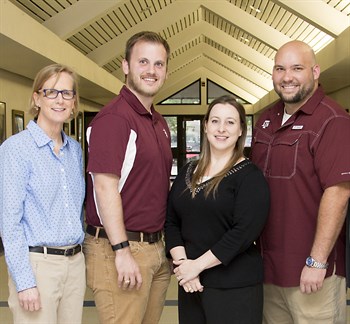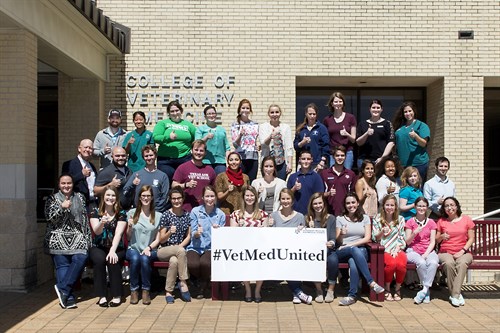Valuing Mental Health, Valuing the Veterinary Community

Veterinary students face numerous challenges every day. Long hours, high-pressure exams, and large volumes of content to absorb are just a few of the stresses veterinary students are faced with; these challenges don’t end after graduation either. Demanding situations and long workdays can also take a toll on a veterinarian’s mental health.
Mental health issues affect the veterinary community disproportionately compared to the general population, according to a paper published in “Social Psychiatry and Psychiatric Epidemiology.” Approximately 21 percent of veterinarians in the United Kingdom reported suicidal ideations, in contrast to 3.9 percent of the general population. Similarly, a survey of Student American Veterinary Medical Association (SAVMA) members found that approximately 47 percent of respondents report a personal history of depression, anxiety, or substance abuse.
Such statistics are unfortunate and troubling, and though mental health is a difficult subject to tackle, it’s one that the Texas A&M; College of Veterinary Medicine & Biomedical Sciences (CVM) refuses to ignore. Through a number of efforts, the college is working to promote the mental well-being of veterinary students by decreasing the stigma associated with mental illness, fostering mental and physical wellness programs, and providing easily accessible counseling services.
Achieving Balance
At the heart of the CVM’s mental health efforts is the notion of achieving balance. Many of the pressures associated with being a veterinarian cannot be removed, but how an individual responds to these pressures can be managed.
In particular, the CVM is considering the importance of resilience, or how an individual can bounce back from challenges and difficulties. Dr. Laura Peycke, clinical associate professor at the CVM, noted how the veterinary community can benefit from resilience and suggested reframing thinking, moderating stress, and managing emotions as a few ways to be resilient.
“How can we promote resilience? As instructors, we must focus on helping students learn to recenter or ‘bounce back’ in response to the rigors of veterinary life,” said Dr. Laura Peycke. “More importantly, however, we can be realistic about what level of commitment is sustainable in their careers in veterinary medicine, as it relates to their professional and personal lives.”
Here at the CVM, the push for better wellness begins on day one. The CVM hosts a day dedicated to wellness at orientation for first-year veterinary students. School-life balance and stress management are some of the main topics discussed. Speakers share strategies for prioritizing and improving wellness, as well as where to find additional resources, if needed.
The CVM also hosts monthly Lunch & Learns centered around stress management, creating balance, and other wellness topics.
Student Efforts

Many of the efforts to support mental wellness begin with the students. Chris Dolan, a fourth-year veterinary student and president of the Student Chapter of the American Veterinary Medical Association (SCAVMA), saw the need to schedule breaks for veterinary students studying for finals. Dolan started “Find the Joy Week,” which offers veterinary students a chance to take a break the week before finals through events such as yoga classes and ice skating.
“Getting students to take time for themselves during finals is vital to keep them from burning out,” Dolan said. “My hope is that these events help students have fun and relieve the stress of finals while spending time with their classmates.”
Student efforts go beyond the CVM. Fourth-year veterinary student, Mike McEntire, serves on the SAVMA Wellness Task Force and helped create the “It’s OK” campaign, which aims to reduce the stigma associated with mental health in the veterinary community. The campaign includes a video reaching out to veterinary students who may be suffering from a mental illness to say that they are not alone and it’s okay to seek help.
“As we began talking about wellness, I had students in every year approach me, telling me their own stories of struggling with wellness,” McEntire said. “None of them had wanted to talk about it, because nobody was talking about it. So we created our ‘It’s OK’ campaign to let everybody know that it’s okay to talk about these issues.”
Additionally, McEntire and the SAVMA Wellness Taskforce conducted a wellness survey to better understand the struggles faced by veterinary students. “We asked the 14,000 SAVMA members to take this survey, and nearly 4,000 of them responded, showing just how much students care about this issue,” McEntire said. “We found that 67 percent of veterinary students have experienced a period of depression, and that 37 percent of students said those periods lasted longer than two weeks, which is the clinical definition of depression. Five percent of veterinary students reported having seriously contemplated suicide.”
Counseling at the CVM
A minute’s walk from the CVM’s main entrance is an in-house counselor, Lanice Chappell, who is available for individual counseling sessions. Chappell is a counselor with Texas A&M;’s Student Counseling Service (SCS), whose office serves as a satellite of the SCS within the CVM.
“The deans and many others recognized it was difficult for veterinary students to access the main counseling office because of the students’ very full schedules,” Chappell said. “The partnership between the SCS and CVM was created to reduce accessibility barriers for veterinary students.”
A number of the services available to students on main campus are available nearby for students in the vet school, such as personal, career, and even couples counseling.
“Being embedded in the CVM school directly has allowed me to interact with students outside of the counseling office at orientation, outreaches, and in the hallways so that stigma is reduced,” Chappell said.
While Chappell mainly focuses on individual counseling, she also offers workshops, some of which are presented in collaboration with the Texas A&M; Professional Program’s Office. “We’ve presented topics on stress management, habit formation, communication, nutrition, and many others.”
In particular, one program that Chappell leads and recommends is QPR-which stands for Question, Persuade, and Refer-training, which focuses on suicide prevention. QPR training is open to faculty, students, and staff throughout Texas A&M; and is held throughout the semester.
Changing the Culture
Change does not come easy, but when it comes to the health and well-being of the veterinary community, change may be necessary. Numerous faculty members in the CVM have called for a cultural change to combat mental illness.
The CVM recognizes the importance of mental health through efforts to increase and emphasize diversity. “A sense of belonging and inclusion is closely linked to an individual’s happiness. We want each student to feel as if they are part of the woven fabric that constitutes the DVM family,” Chappell said.
Peycke offered several recommendations for how professors can facilitate a cultural change. She suggests breaking down the illusion of perfection by being open and admitting that we all have bad days. Additionally, she suggests professors inviting students to participate in hobbies outside of the classroom.
“I try to let the students know that it is unrealistic to think that we are going to be perfect every day,” Peycke said. “Rather, it is more about showing up with the willingness to try to help and maintain the attitude that we are going to do our very best. It is that simple.”
Part of changing the culture also means recognizing when someone is struggling and helping them get the help they need. “We are a community, and as such, it’s more likely someone else will notice if a person is struggling before that individual reaches out to me,” Chappell said; however, she cautioned that “forcing someone to come see me is usually a recipe for a poor treatment outcome because the student may feel the referral is punitive. We encourage faculty, staff, and peers to connect with the person and let them know people care and would like to help. Help can be as simple as a listening ear free from judgment or advice.”
Changing the culture and successfully combating mental health issues won’t happen overnight. Instead, the CVM’s faculty, students, and staff are chipping away at the stigma and adversity associated with mental illness and moving toward a healthier, happier, and more well-rounded veterinary community.
Need Help?
To learn more about the services offered at the Student Counseling Service, visit scs.tamu.edu or call 979.845.4427. From 4 p.m. to 8 a.m. during weekdays and all weekend, students can reach the Student Counseling Help Line at 979.845.2700.
If you are CVM staff or faculty and are worried about a student, please contact the Professional Programs Office at 979.845.3878. Additionally, students, faculty, and staff can visit TellSomebody.tamu.edu to report concerning behavior.


